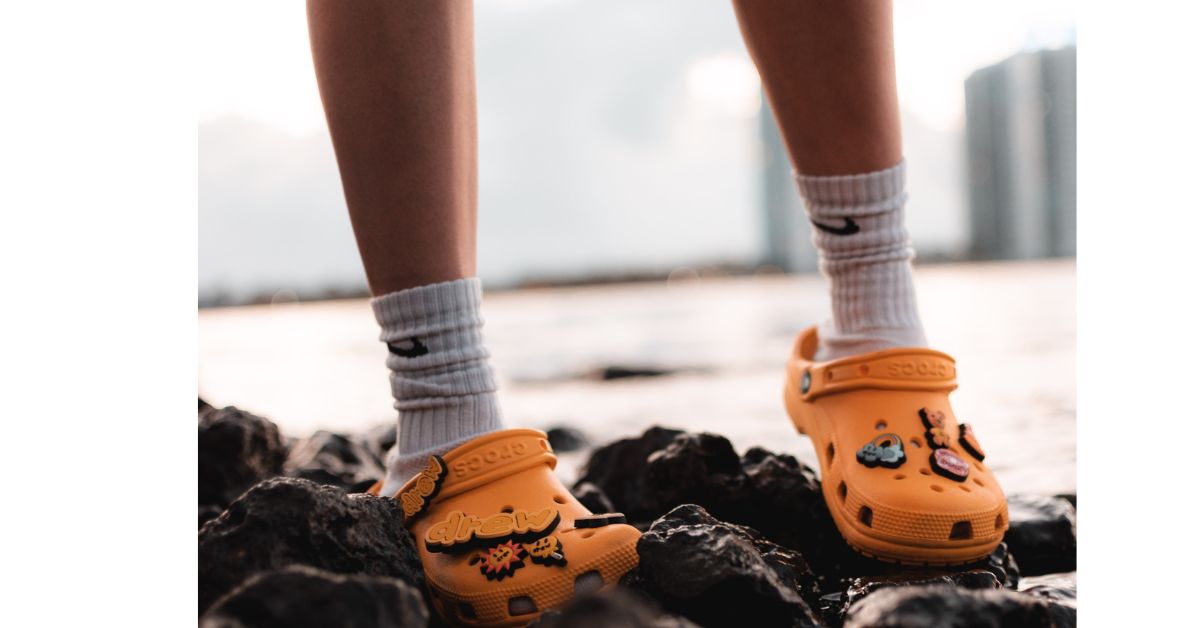Are you thinking of taking a hike in your Crocs? You’re not alone. Crocs have become a fashion staple for many, and now people are wondering if they can take these shoes off the pavement and into the great outdoors. While the idea of hiking with Crocs may sound strange, there are some great benefits to wearing them. In this guide, we’ll take a look at the pros and cons of hiking in Crocs and ultimately determine whether or not it’s a good idea.
So, if you want to make your next outdoor adventure more comfortable, let’s dive in and see if Crocs are the right choice.
Comfort and Breathability
Taking a leisurely stroll in a pair of Crocs is like walking on clouds – heavenly and blissful! The light weight of the shoe, combined with the foam-like cushioning, makes for a comfortable and supportive ride, no matter how far you’re going.
Related: Are Vans Good For Hiking?
The perforations across the shoe encourage airflow, ensuring your feet won’t overheat and get sweaty. The breathable material is also flexible, so it won’t rub or cause blisters – an important factor when it comes to long hikes.
Durability and Water-Resistance
Crocs are made with a durable material that withstands wear and tear. They possess water-resistant properties, although they are not completely waterproof.
These shoes are made using a material called Croslite, which is a foam known for its ability to repel water. Consequently, they are not prone to easy water absorption, but they can still become wet if submerged or exposed to heavy rainfall.
It is advisable to opt for closed-sided Crocs to ensure dryness during wet conditions. These particular designs prevent water from entering the shoe, even when stepping in puddles or submerging them underwater. Keep this in mind when hiking in a place with puddles while wearing your Crocs.

To maintain dryness when using Crocs for hiking, consider the following tips:
- Refrain from wearing them in heavy rain or situations where submersion in water is expected.
- Select Crocs with closed sides.
- Dry your Crocs after each use.
- Apply a water-repellent spray to your Crocs.
- Avoid wearing them in hot and humid weather.
If your Crocs become wet, air-dry them or use a hair dryer in a cool setting. Remember to avoid using a dryer, as it can cause damage to the shoes.
Related: Can You Hike In Doc Martens?
Weight and Flexibility of Crocs Hiking Shoes
Hiking in Crocs means you can walk for miles without feeling weighed down. The lightweight material prevents your feet from tiring out too quickly.
Crocs are also flexible, allowing you to take on any terrain easily. Whether you’re scaling a steep incline or trekking through mud, you can trust that your Crocs will keep up with you.
Traction and Grip
When it comes to traction, Crocs hiking shoes generally offer decent grip and stability on various surfaces. However, their traction performance can vary depending on the specific model and the condition of the surface you are walking on.
Crocs have some inherent slip resistance. The tread patterns on the outsole of Crocs are designed to provide traction and prevent slipping. They often feature raised patterns or grooves that can help channel water or debris away from the sole, enhancing grip.
In dry conditions, Crocs generally provide good traction on surfaces like pavement, tile floors, or dry grass. They are particularly popular for activities like boating or gardening, where a non-slip sole can be beneficial. However, it’s worth noting that the level of traction may not be as high as specialized shoes designed for specific activities like hiking or running.
Traction in slippery conditions
In wet or slippery conditions, the performance of Crocs can vary. While the tread patterns on the outsole can help to some extent, the overall traction may be compromised on extremely slippery surfaces. It’s always important to exercise caution when hiking on wet or icy trails.
Ultimately, while Crocs generally offer decent traction for everyday use and casual activities, they may not be the best choice for hikes requiring high-performance grip.
Versatility and Cost-Effectiveness
Not only are Crocs comfortable and versatile, but they’re also cost-effective. You don’t have to break the bank to get the most out of your outdoor experiences.
With various styles and prices, you can find the perfect pair that meets your needs and budget. Plus, with easy-to-clean material, you can keep your Crocs looking great and ready for your next adventure.
Style and Color Options
With a wide range of colors and styles to choose from, you can pick the perfect pair to express yourself and make your outdoor experiences even more memorable. Crocs hiking shoes come in a variety of styles, from classic clogs to sandals and boots.
With all these options, you can find a pair of hiking Crocs to match any outfit or mood. Bold colors like neon pink, electric blue, and lime green can add a fun touch to any hike, while more subtle colors like brown, navy, and gray can help keep your look understated.
There’s also a range of designs and patterns to choose from, so you can find the perfect style to complete your look.

Disadvantages of Hiking in Crocs
Hiking in Crocs, despite their comfort and casual appeal, may not be the ideal choice for several reasons. Here are three disadvantages to consider:
- Lack of Ankle Support: Crocs are designed with a low-profile structure that does not provide the same level of stability and protection as hiking boots or shoes. While they may be suitable for short walks or easy terrain, hiking trails often involve uneven surfaces, rocks, and potential obstacles. Insufficient ankle support increases the risk of sprains or injuries, especially during challenging hikes or when carrying heavy backpacks.
- Limited Foot Protection: The open design of hiking Crocs exposes your feet to potential hazards such as sharp rocks, thorns, branches, or even biting insects. On the other hand, hiking boots or shoes feature sturdier materials and construction. This includes reinforced toe caps and thicker soles, which provide better protection against external elements.
- Inadequate Traction: While Crocs offer decent traction for everyday use, their grip may not be sufficient for hiking on more demanding terrains. Hiking trails often involve loose gravel, muddy sections, slippery surfaces, or steep inclines, where a firm grip is essential for safety. Crocs may lack the specialized tread patterns, aggressive lugs, and durable outsole materials found in hiking footwear designed specifically for challenging terrains. This can compromise your stability and increase the risk of slipping or falling during hikes.
Final Verdict: Is it Recommended?
On one hand, the lightweight design and comfort of Crocs make them a great option for a day hike. They’re easy to slip on and off, and the ventilation keeps your feet cool.
On the other hand, the lack of arch support and grip makes them unsuitable for more rigorous activities.
At the end of the day, it’s up to you to decide if you’d like to use Crocs for hiking. Just remember all the potential risks associated with them, and wear a sturdy pair of socks for extra protection.
With that in mind, you can confidently set off on your next outdoor adventure, knowing you’ll be comfortable and well-equipped.

